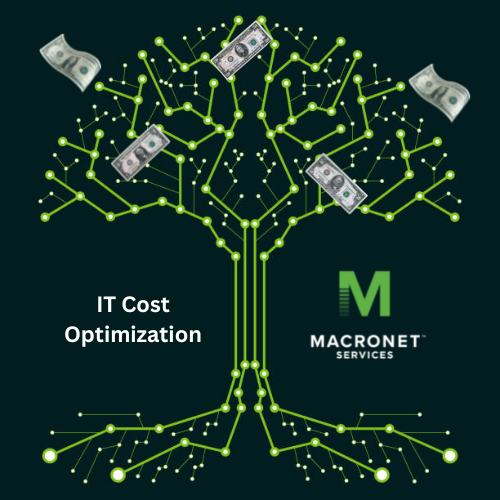IT Cost Optimization Best Practices
IT cost optimization is the process of reducing the cost of operating and maintaining an organization’s IT infrastructure while still delivering the desired level of service and value. The goal of IT cost optimization is to minimize spending while still meeting the needs and requirements of the business. Some of the methods used to achieve IT cost optimization include:
- Telecom Expense Management: A process of controlling and reducing the costs of an organization’s telecommunications services.
- Cloud Cost Management: reducing the cost of operating and maintaining a cloud computing environment while still meeting the needs and requirements of the business.
- SaaS Cost Management: The process of reducing the cost of using SaaS applications.
- Right-sizing: Choosing the right hardware, software, and services that meet the needs of the business and not over-purchasing unnecessary resources.
- Automation: Automating repetitive and manual tasks to reduce the time and resources required to perform these tasks.
- Consolidation: Consolidating multiple IT systems into a single, more cost-effective solution to reduce the number of hardware and software systems required.
- Energy efficiency: Implementing energy-efficient technologies and processes to reduce the energy consumption of IT equipment and reduce costs.
By adopting these best practices, organizations can minimize the cost of operating and maintaining their IT infrastructure while still delivering the desired level of service and value. It’s important to regularly review and optimize IT costs to ensure that resources are being used in the most cost-effective way.
In this blog we will focus in on three critical areas:
- Telecom Expense Management
- Cloud Cost Management
- SaaS Cost Management
Telecom Expense Management
Telecom Expense Management (TEM) is a process of controlling and reducing the costs of an organization’s telecommunications services. In today’s fast-paced and highly competitive business environment, managing telecom expenses has become a crucial aspect of any organization’s financial strategy. The process of TEM involves a wide range of activities such as auditing invoices, tracking usage, negotiating contracts, and providing detailed reporting.
Why TEM is important?
Cost savings: The biggest advantage of TEM is that it can help organizations save significant amounts of money on their telecom expenses. Through detailed analysis of usage patterns and contract negotiations, TEM can help organizations identify opportunities to reduce costs and eliminate unnecessary spending. The team at Macronet Services regularly identifies network circuits that have been sitting unused for years and yet have remained on the bill, costing clients tens of thousands of dollars annually. Nearly 100% of POTs (plain old telephone service) audits generate cost savings and are now a critical target for copper replacement.
Increased efficiency: With TEM, organizations can streamline their billing and procurement processes, resulting in increased efficiency and reduced manual labor. This allows employees to focus on higher-value activities and eliminates the risk of manual errors.
Improved decision making: TEM provides organizations with the necessary data and insights to make informed decisions regarding their telecom services. Detailed reporting and analysis can help organizations understand how telecom services are being used and identify opportunities for optimization.
Key Components of TEM
- Auditing: TEM starts with auditinginvoices to ensure that organizations are only paying for services they use and that they are receiving the best possible rates.
- Usage tracking: TEM also involves tracking usage patterns to identify areas where usage is excessive and where cost-saving opportunities may exist.
- Contract negotiation: Once usage patterns have been identified, TEM can help organizations negotiate better contracts with their service providers.
- Reporting and analysis: TEM provides organizations with detailed reporting and analysis, allowing them to understand their telecom expenses and make informed decisions.
A competent TEM services provider will have in-house expertise that is technically competent with telecom network services and can make network design and sourcing recommendations in alignment with the client’s long-term network strategy. Team members at Macronet Services have over 20 years of experience in global network design and sourcing.
In conclusion, TEM is an essential process for organizations looking to control and reduce their telecom expenses. By providing cost savings, increased efficiency, and improved decision making, TEM can help organizations achieve their financial goals and remain competitive in today’s rapidly evolving business environment.
Cloud Cost Optimization
Cloud cost optimization is the process of reducing the cost of operating and maintaining a cloud computing environment while still meeting the needs and requirements of the business. This can be achieved through various methods such as:
- Right-sizing: Optimizing cloud instances by choosing the right size for each instance, so that resources are not over-provisioned or under-utilized.
- Cost-effective storage: Using cost-effective storage options, such as object storage or infrequent access storage, for data that is not frequently accessed.
- Automated resource management: Automating the process of managing cloud resources, such as shutting down or resizing instances when they are no longer needed.
- Cost-effective services: Choosing cost-effective services and products that fit the needs of the business, rather than the most expensive options.
- Monitoring and tracking: Continuously monitoring and tracking cloud usage and costs to identify areas where optimization can be made.
- Cost-effective region and provider: Selecting the most cost-effective region and provider for the cloud services being used, based on factors such as data transfer costs and pricing.
By implementing these techniques and working win an expert in FinOps, organizations can reduce the cost of operating their cloud environment while still maintaining the necessary performance and availability for their business. It’s critical to implement processes to regularly review and optimize cloud costs to ensure that resources are being used in the most cost-effective way.
SaaS Cost Management
SaaS (Software as a Service) cost optimization is the process of reducing the cost of using SaaS applications while still getting the desired value and benefits. The goal of SaaS cost optimization is to minimize spending while still meeting the needs and requirements of the business. “License sprawl” can quickly run up monthly operational expenses unnecessarily and should be a key target area for immediate cost savings by the offices of the CFO and CIO. Some of the methods used to achieve SaaS cost optimization include:
- Right-sizing: Choosing the right plan or package that meets the needs of the business and not over-purchasing unnecessary features or services.
- Usage monitoring: Regularly monitoring usage patterns to identify areas where the business is over-spending or under-utilizing resources.
- License management: Properly managing licenses and subscription plans to avoid paying for unused services or over-purchasing licenses.
- Contract negotiation: Negotiating contracts and pricing with SaaS providers to ensure that the business is getting the best possible pricing.
- Consolidation: Consolidating multiple SaaS applications into a single, more cost-effective solution to reduce the number of subscriptions and licenses required.
- Automated cost optimization: Implementing automated tools and processes to monitor and optimize SaaS costs on an ongoing basis.
Often, our clients start with simple SaaS audit. A SaaS (Software as a Service) audit is a systematic review of an organization’s use and expenditure on SaaS applications. The purpose of a SaaS audit is to identify areas where costs can be optimized, improve the alignment of SaaS usage with the organization’s goals and objectives, and ensure that SaaS contracts are being used in the most cost-effective and efficient manner.
A SaaS audit typically involves the following steps:
- Inventory collection: Gathering a complete inventory of all SaaS applications in use, including the name of the provider, the purpose of the application, and the number of licenses in use.
- Usage analysis: Analyzing usage patterns to identify areas where the business is over-spending or under-utilizing resources.
- Contract review: Reviewing SaaS contracts and agreements to ensure that they are in compliance with the organization’s policies and that the business is getting the best possible pricing.
- Cost analysis: Analyzing costs to identify areas where optimization can be made and determining the most cost-effective SaaS solutions for the business.
- Recommendations: Making recommendations for optimizing SaaS costs, such as consolidating multiple SaaS applications into a single solution, negotiating better pricing, or right-sizing plans and packages.
A SaaS audit is an important step in ensuring that an organization’s SaaS expenditures are aligned with its goals and objectives, and that SaaS costs are optimized. The results of a SaaS audit can provide organizations with valuable insights into their SaaS usage and costs, allowing them to make informed decisions about their SaaS investments.
By adopting these best practices, organizations can minimize the cost of using SaaS applications while still getting the desired value and benefits. Macronet Services has leading edge SaaS optimization technologies available to our clients that can be immediately implemented for a quick return.
The amount of money that organizations waste on SaaS (Software as a Service) can vary greatly depending on several factors, including the size of the organization, the number of SaaS applications in use, and the degree to which SaaS costs are managed and optimized.
According to some estimates, organizations can waste up to 30% of their SaaS budget on over-provisioning, under-utilization, and paying for unused licenses or services. In addition, organizations may also pay more than necessary for SaaS applications due to poor contract negotiation, failing to right-size plans and packages, or not consolidating multiple SaaS applications into a single solution.
However, it’s important to note that not all organizations waste the same amount on SaaS. Some organizations may waste very little, while others may waste significantly more.
Conclusion
CIOs and CFO looking to identify and take quick action to achieve cost savings can focus cost Telecom Expense Management, Cloud Cost Management, and SaaS Cost Management and will likely see immediate return. Additionally, they can implement the controls necessary to manage costs over the long-term and to have the visibility necessary to make impactful architecture changes. The experienced team at Macronet Services can direct you to the best options available for cost management. Contact us anytime for conversation about your challenges.
Related Posts
Recent Posts
- Securing Autonomous AI Agents: Identity-Anchored Autonomy for Enterprise Risk & Resilience
- The Definitive Guide to Enterprise Telecom Agreements: MSA, SLA, and DIA Negotiation Best Practices for Global Carriers
- The AI Privacy Engineer: Architecting Trust and Compliance in the Age of AI
- AI in CCaaS RFPs: Essential Features for Next-Gen Contact Centers
- The Future of CCaaS: How AI Will Transform Contact Centers by 2035
Archives
- October 2025
- September 2025
- August 2025
- July 2025
- June 2025
- May 2025
- April 2025
- March 2025
- February 2025
- January 2025
- December 2024
- November 2024
- October 2024
- September 2024
- August 2024
- July 2024
- June 2024
- May 2024
- April 2024
- March 2024
- February 2024
- January 2024
- December 2023
- November 2023
- October 2023
- September 2023
- August 2023
- July 2023
- June 2023
- May 2023
- April 2023
- March 2023
- February 2023
- January 2023
- December 2022
- November 2022
- October 2022
- September 2022
- August 2022
- July 2022
- June 2022
- May 2022
- April 2022
- March 2022
- February 2022
- January 2022
- December 2021
- November 2021
- October 2021
- September 2021
- August 2021
- July 2021
- June 2021
- May 2021
- April 2021
- March 2021
- December 2020
- September 2020
- August 2020
- July 2020
- June 2020
Categories
- All (19)
- Satellite (1)
- Artificial Intelligence (8)
- Travel (1)
- Sports (1)
- Music (1)
- News (280)
- Design (3)
- Clients (12)
- Uncategorized (1)
- Tips & tricks (25)
- Inspiration (9)
- Client story (1)
- Unified Communications (196)
- Wide Area Network (309)
- Cloud SaaS (60)
- Security Services (71)




